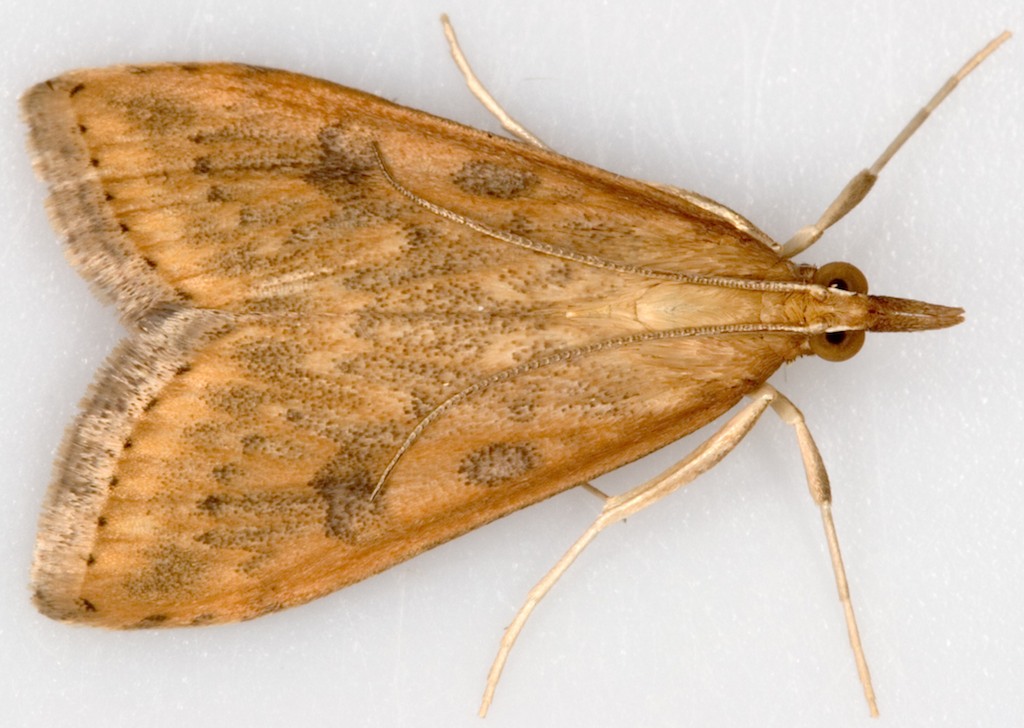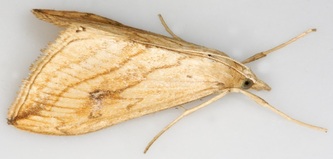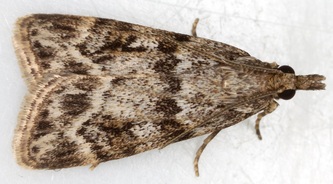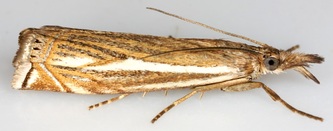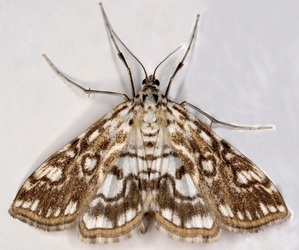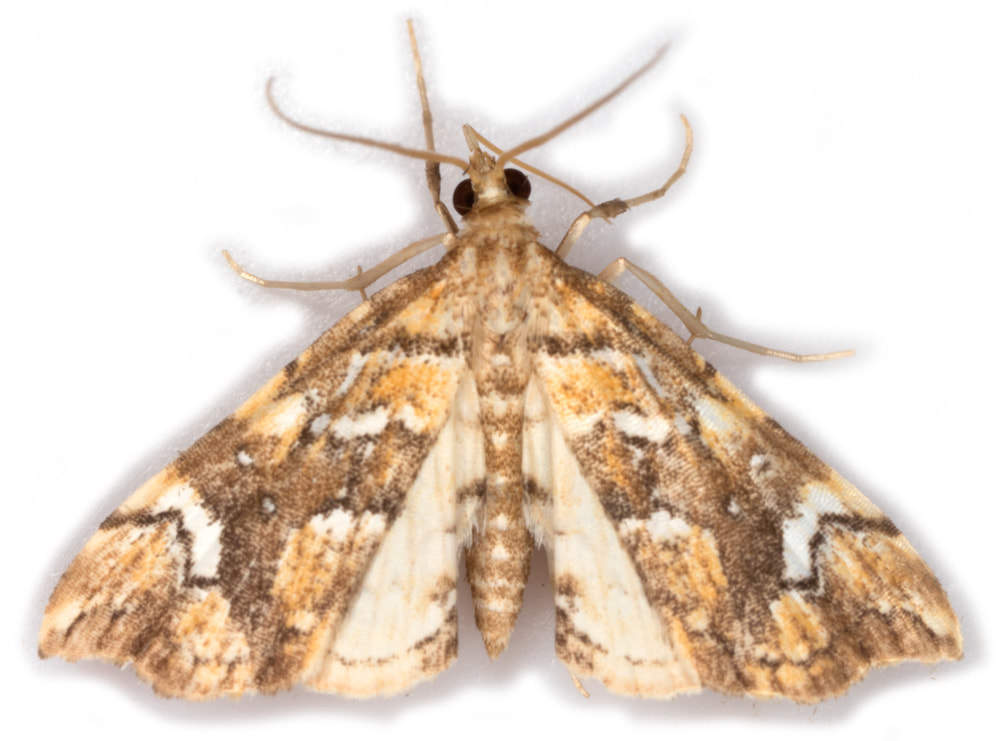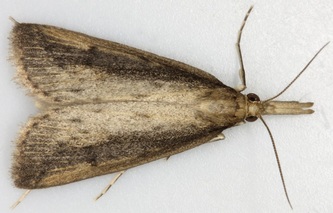Suborder:Glossata Infraorder:Heteroneura Division:Ditrysia Section:Tineina Subsection:Tineina Superfamily:Pyraloidea
Ref: British Pyralid Moths, Goater, 1986 where the subfamilies included here are considered within Family: Pyralidae
Features common to Superfamily: Pyraloidea - Families: Crambidae and Pyralidae
Key (MBGBI2): Cilia of hindwing shorter than breadth of hindwing; frenulum present; proboscis scaled; hindtibia smooth, maxillary palp present.
Hindwing V7&8 fused for some distance beyond cell; Tympanal organs at base of abdomen (a feature shared only with Family:Geometridae)
Slender-bodied; Antennae long, directed backwards at rest; Forewing narrow or broadly triangular; hindwing always broad; both pairs of wings with short cilia; Labial palps usually long, porrect or upturned; Legs long and slender
Crambidae & Pyralidae differ in the presence of a 'praecinctorium', a structure joining the 2 tympanic membranes, in Crambidae and its absence in Pyralidae
Ref: British Pyralid Moths, Goater, 1986 where the subfamilies included here are considered within Family: Pyralidae
Features common to Superfamily: Pyraloidea - Families: Crambidae and Pyralidae
Key (MBGBI2): Cilia of hindwing shorter than breadth of hindwing; frenulum present; proboscis scaled; hindtibia smooth, maxillary palp present.
Hindwing V7&8 fused for some distance beyond cell; Tympanal organs at base of abdomen (a feature shared only with Family:Geometridae)
Slender-bodied; Antennae long, directed backwards at rest; Forewing narrow or broadly triangular; hindwing always broad; both pairs of wings with short cilia; Labial palps usually long, porrect or upturned; Legs long and slender
Crambidae & Pyralidae differ in the presence of a 'praecinctorium', a structure joining the 2 tympanic membranes, in Crambidae and its absence in Pyralidae
Subfamily: Pyraustinae (11G 30S)
Fairly broad wings, often strongly patterned, long legs. Larvae are web-spinners or leaf-rollers.
Genera: Paracorsia, Loxostege, Pyrausta (8S), Uresiphita (2S), Nascia, Sitochroa (2S), Anania (10S), Sclerocona, Psammotis, Ostrinia, Paratalanta (2S)
Subfamily: Spilomelinae (17G 25S)
Included in subfamily Pyraustinae in Goater
Genera: Udea (7S), Pleuroptya, Mecyna (2S), Agrotera, Diplopseustis, Diasemia, Diasemiopsis, Maruca, Duponchelia, Spoladea, Palpita, Hodebertia, Dolicharthria, Antigastra, Nomophila (2S), Cydalima, Herpetogramma
Subfamily: Odontiinae (1G 1S)
Separated on basis of genital structure
Genus: Cynaeda
Subfamily: Glaphyrinae (2G 5S)
Separated on the basis male genital structure but otherwise resemble Pyraustinae in having broadly triangular forewings and slender legs
Genera: Evergestis (4S), Hellula (1S)
Subfamily: Scopariinae (2G 14S)
Small, triangular-winged, greyish. Rest on tree-trunks, walls or rocks.
Genera: Scoparia (5S), Eudonia (9S)
Subfamily: Crambinae (13G 38S)
The grass moths - characterised by narrow forewings and broad hindwings, so that they look much larger in flight than at rest.
Easily disturbed from grasses during day and settled head-down with wings wrapped tightly around body, on grass stems.
Genera: Euchromius, Chilo, Friedlanderia, Calamatropha, Chrysoteuchia, Crambus (8S), Agriphila (7S), Catoptria (9S), Chrysocrambus (2S), Thisanotia, Pediasia (3S), Platytes (2S), Ancylolomia
Subfamily: Acentropinae (5G 5S)
Characterised by aquatic larvae - Acentria with its brachypterous aquatic females and the china-mark moths which were formerly placed in a separate subfamily (Nymphulinae).
Genera: Elophila, Acentria, Cataclysta, Parapoynx, Nymphula
Subfamily: Musotiminae (1G 1S)
Genus: Musotima
Subfamily: Schoenobiinae (2G 3S)
Long-winged and long-legged; associated with waterside vegetation; sexually dimorphic - females having longer more pointed wings than males
Genera: Schoenobius, Donacaula (2S)
Fairly broad wings, often strongly patterned, long legs. Larvae are web-spinners or leaf-rollers.
Genera: Paracorsia, Loxostege, Pyrausta (8S), Uresiphita (2S), Nascia, Sitochroa (2S), Anania (10S), Sclerocona, Psammotis, Ostrinia, Paratalanta (2S)
Subfamily: Spilomelinae (17G 25S)
Included in subfamily Pyraustinae in Goater
Genera: Udea (7S), Pleuroptya, Mecyna (2S), Agrotera, Diplopseustis, Diasemia, Diasemiopsis, Maruca, Duponchelia, Spoladea, Palpita, Hodebertia, Dolicharthria, Antigastra, Nomophila (2S), Cydalima, Herpetogramma
Subfamily: Odontiinae (1G 1S)
Separated on basis of genital structure
Genus: Cynaeda
Subfamily: Glaphyrinae (2G 5S)
Separated on the basis male genital structure but otherwise resemble Pyraustinae in having broadly triangular forewings and slender legs
Genera: Evergestis (4S), Hellula (1S)
Subfamily: Scopariinae (2G 14S)
Small, triangular-winged, greyish. Rest on tree-trunks, walls or rocks.
Genera: Scoparia (5S), Eudonia (9S)
Subfamily: Crambinae (13G 38S)
The grass moths - characterised by narrow forewings and broad hindwings, so that they look much larger in flight than at rest.
Easily disturbed from grasses during day and settled head-down with wings wrapped tightly around body, on grass stems.
Genera: Euchromius, Chilo, Friedlanderia, Calamatropha, Chrysoteuchia, Crambus (8S), Agriphila (7S), Catoptria (9S), Chrysocrambus (2S), Thisanotia, Pediasia (3S), Platytes (2S), Ancylolomia
Subfamily: Acentropinae (5G 5S)
Characterised by aquatic larvae - Acentria with its brachypterous aquatic females and the china-mark moths which were formerly placed in a separate subfamily (Nymphulinae).
Genera: Elophila, Acentria, Cataclysta, Parapoynx, Nymphula
Subfamily: Musotiminae (1G 1S)
Genus: Musotima
Subfamily: Schoenobiinae (2G 3S)
Long-winged and long-legged; associated with waterside vegetation; sexually dimorphic - females having longer more pointed wings than males
Genera: Schoenobius, Donacaula (2S)

